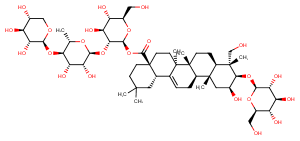Polygalasaponin F
| Code | Size | Price |
|---|
| TAR-T3826-20mg | 20mg | £151.00 | |||||||||||||||||||||||||||||||||||||||||||||||||||||||||||||||||||||||||||||||||||||||||||||||||
| Special offer! Add £1 to your order to get a TargetMol CCK-8 Kit. Read more here. | |||||||||||||||||||||||||||||||||||||||||||||||||||||||||||||||||||||||||||||||||||||||||||||||||||
Quantity:
| TAR-T3826-1mL | 1 mL * 10 mM (in DMSO) | £167.00 | |||||||||||||||||||||||||||||||||||||||||||||||||||||||||||||||||||||||||||||||||||||||||||||||||
| Special offer! Add £1 to your order to get a TargetMol CCK-8 Kit. Read more here. | |||||||||||||||||||||||||||||||||||||||||||||||||||||||||||||||||||||||||||||||||||||||||||||||||||
Quantity:
Prices exclude any Taxes / VAT
Overview
Regulatory Status: RUO
Shipping:
cool pack
Storage:
-20℃
Images
Documents
Further Information
Bioactivity:
Polygalasaponin F has anti-neuroinflammatory activity, can inhibit the release of inflammatory cytokines TNF-α and NO induced by lipopolysaccharides (LPS) and reduce the expression of inducible nitric oxide synthases. Polygalasaponin F can significantly inhibit the cytotoxicity of conditioned medium prepared by LPS-stimulated BV-2 microglia (LPS conditioned media) to neuronal PC12 cells and improve cell viability. Polygalasaponin F can induce long-term potentiation in hippocampal dentate gyrus in anesthetized rats via NMDAR activation mediated by Ca(2+)/calmodulin-dependent kinase II, extracellular signal-regulated kinase and cAMP response element-binding protein signaling pathway. PS-F inhibits the secretions of neuroinflammatory cytokines by the regulation of the NF-kB-signaling pathway.
CAS:
882664-74-6
Formula:
C53H86O23
Molecular Weight:
1091.248
Pathway:
Immunology/Inflammation; PI3K/Akt/mTOR signaling; NF-κb; Cytoskeletal Signaling
Purity:
0.9975
SMILES:
C[C@@H]1O[C@@H](O[C@@H]2[C@@H](O)[C@H](O)[C@@H](CO)O[C@H]2OC(=O)[C@]23CCC(C)(C)C[C@H]2C2=CC[C@@H]4[C@@]5(C)C[C@H](O)[C@H](O[C@@H]6O[C@H](CO)[C@@H](O)[C@H](O)[C@H]6O)[C@@](C)(CO)[C@@H]5CC[C@@]4(C)[C@]2(C)CC3)[C@H](O)[C@H](O)[C@H]1O[C@@H]1OC[C@@H](O)[C@H](O)[C@H]1O
Target:
NF-κB; TLR; Akt; PI3K
References
Zhou W,et al. Quantification of polygalasaponin F in rat plasma using liquid chromatography-tandem mass spectrometry and its pharmacokinetics application. Biomed Chromatogr. 2015 Sep;29(9):1388-92.
Wei WWei ,et al. Polygalasaponin F inhibits secretion of inflammatory cytokines via NF-?B pathway regulation. J Asian Nat Prod Res. 2014;16(8):865-75.



